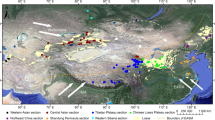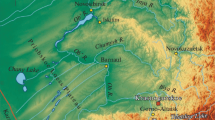Abstract
The loess/paleosol sequences of Central Asia are continuous terrestrial records of the Quaternary period and enable detailed comparison with paleoclimatic archives such as marine and ice core records in order to reconstruct regional and global paleoclimatic and paleoecological development during the past 130 000 years. Thermoluminescence (TL) and infrared stimulated luminescence (IRSL) dating methods are applied to the extensively studied loess/paleosol sequence of the section at Darai Kalon/Chashmanigar, Tadjikistan, in order to determine a more accurate chronological framework and climatostratigraphic reconstruction for the last interglacial/glacial cycle. Luminescence dating suggests that the loess above the first pedocomplex from the top, PC1, accumulated during the last glacial period. A high accumulation rate of up to 1.20 m per 1000 years was determined for the last glacial loess, especially for the uppermost 5–8 m. PC1 formed during the last interglacial period (oxygen-isotope stage 5). The loess between PC1 and PC2 is designated to be of penultimate glacial deposition age. Infrared stimulated luminescence and TL age estimates are in agreement to 80 000 years before present (BP), indicating a long-distance transport of the aeolian dust prior to deposition. The upper numerical age-limit range is between 300 000 and 450 000 years. However, reliable dating of the loess older than 130 000 years is not possible due to age scatter between samples and an inadequate increase of paleodose with depth. This high-resolution dating study underlines the importance of the section at Darai Kalon and indicates that it is one of the most continuous loess/paleosol records of the Northern Hemisphere. The chronological results are particularly important for the reconstruction of the human evolution in Central Asia, suggesting much older age estimates than previously obtained for most of the archeological key sites associated with PC5 and PC4 in Tadjikistan.
Similar content being viewed by others
Author information
Authors and Affiliations
Additional information
Received: 18 August 1997 / Accepted 23 December 1997
Rights and permissions
About this article
Cite this article
Frechen, M., Dodonov, A. Loess chronology of the Middle and Upper Pleistocene in Tadjikistan. Geol Rundsch 87, 2–20 (1998). https://doi.org/10.1007/s005310050185
Issue Date:
DOI: https://doi.org/10.1007/s005310050185




